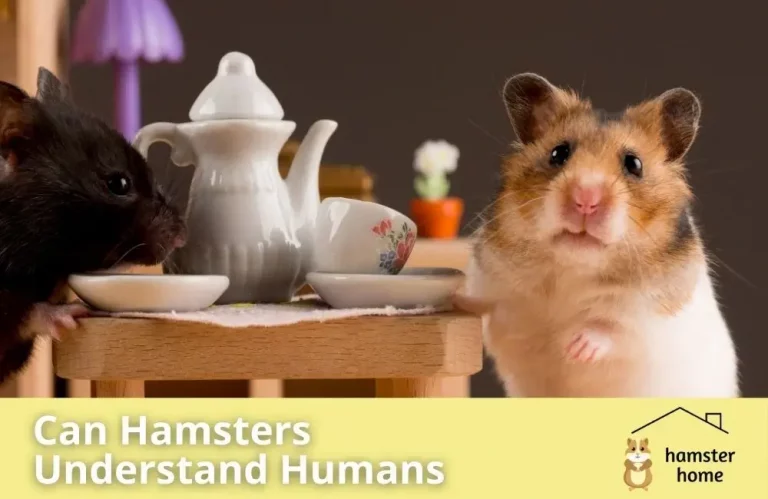If you already own a pet, such as a dog or a cat, you might have felt that these animals somehow connect them with humans. You might often think that your pet can understand you. But, while looking at a hamster, you may be confused. There are not like other pets. The mini creatures have their way of expressing themselves to the world and their human companions. So, wondering that can hamsters understand humans?
To help you become a responsible pet parent for a hamster, here we have all that you need to know before adopting one.
Can Hamsters Understand Human Language?
No, hamsters can’t understand human language. Some studies say that hamsters are intelligent and can learn their name. But being able to recognize his name doesn’t, your hamster can understand human language. It may be your tone of voice and body language that can help your hamster understand you, not your language.
Do Hamsters Understand When You Talk to Them?
There is not a strict yes or no answer to this question. While a hamster will be able to understand your gestures to some extent, they won’t be able to get your language. They won’t understand which words mean what and how to respond. Experts say that if you train your pet enough, he may be able to understand some words. But by understanding some words, a hamster will not understand you completely when you talk to them.
Do Hamsters Understand Affection?
Yes, you’ll be amazed to learn that hamsters not only understand affection but they crave human affection. As they get emotionally attached to their owners, their love and affection for their owners grow. They have sign language to show that how much attached they are to their pet parents.
Now, as you know that your hamster can understand affection, you’ll not want to make him feel that he isn’t getting enough attention. This can lead to behavioral changes in your hamster and can even cause anxiety or depression. To avoid this situation, it’s essential to keep your hamster happy by ensuring that he gets the love he deserves. Here are some ways to show affection for your hamster to keep him happy:
- Provide Comfortable Living Conditions
Make sure you fulfill all the basic needs of your hamster. No one can stay happy if their basic needs are not being fulfilled. The basic needs for hamsters include all the things that are required to sustain life. These include sufficient amounts of clear water and healthy food.
Moreover, you must ensure that your hamster gets the required sunlight and ventilation. For this, you can place your hamster’s cage at a place where he can receive sufficient but not direct sunlight.
You should also check if the temperature of the surroundings is suitable for your hamster or not. The ideal temperature for hamsters is 70-80°F. If the temperature becomes higher or lower than this, it can negatively affect your hamster’s health. - Keep in Large Enough Cage
Your hamster’s cage shouldn’t be smaller than 2 square feet. The size can be even more if you have more than one hamster. Pet hamsters spend a bigger portion of their lives in a cage. If the cage is small, it can be unhealthy and uncomfortable for your hamster.
To stay happy and healthy, he needs space to play and stay physically active. To ensure your hamster is getting the required physical exercise, a large cage is necessary to provide sufficient space. - Provide All Sorts of Amusement
Even in cages, hamsters need things to amuse themselves to stay happy. These exciting things help them to get rid of boredom, particularly if they don’t have other hamsters to accompany them in the cage.
Besides the food basin and water bottle, you can put some toys and a running wheel in your hamster’s cage. These things will keep him engaged and happy, even on days when you’ll not be able to give him enough attention. But make sure that these toys and other amusement items are cleaned regularly to avoid bacteria and dirt build-up. - Place Your Hamster’s Cage in a Silent Room
Like all other animals and humans, hamsters are happy when they are in a peaceful place. In a silent room, your hamster won’t have to face constant fear, anxiety, or threat that may happen at a noisy place. Also, if you keep them in a room where your cat and dog can’t reach will keep them relaxed. Hamsters are tiny creatures and won’t be comfortable in the presence of bigger pets, especially cats, as they are hamsters’ predators.
Can Hamsters Understand Human Emotions?
No, hamsters can’t understand human emotions. They won’t know when you’re happy, sad, depressed, etc. But they will be able to see a change in your behavior, but they can’t decide if it’s positive or negative.
A hamster will notice your body language and tone of voice. This is the reason behind the confusion that hamsters can understand human emotions. Seeing you acting differently and knowing what you’re feeling are two different things. Unfortunately, your hamster isn’t good at later.
Can Hamsters Communicate with Humans?
Yes, hamsters can communicate with humans using different body languages and displaying different behaviors. Though they can’t understand your emotions, their body language is a way to convey their feelings to you. To have effective communication with your hamster, you have to start with understanding the meaning behind your hamster’s emotions. Some of the common behaviors of hamsters and their meanings are listed in the next section.
Do Hamsters Have Feelings?
Yes, hamsters have feelings that they express through their body language. By observing your hamster carefully, you can understand which behavior expresses which emotion. Your hamster can be happy, sad, threatened, angry, etc. Moreover, they also use sign language to share different feelings.
If you want to be a responsible pet parent, you must learn to understand the meaning of different behaviors of your hamster. It will allow you to help your hamster if he is sick, sad, or afraid of something. It also helps you learn how to train your hamster for different situations.
Here are some of the most common hamster behaviors and their meaning to better understand your hamster’s emotions.
- Digging
A hamster digging or burrowing in the bedding is happy or searching for a hidden treat. He can how this behavior during any part of the day. The meaning will be the same anywhere. - Grooming
In this situation, the hamster needs reassurance and having a feeling of contentment. It means your hamster is happy at the moment he is having and with everything happening around him. - Stretching Limbs
This behavior is common throughout the mammalian kingdom. They stretch their limbs when they are relaxed and happy about the current situation. - Staring With Erect Ears
If you see your hamster staring at something or you with erect ears, then it indicates curiosity. This behavior shows that your hamster is trying to figure out that what’s happening around him. - Cheek Pouches Puffed Up with Ears Forward and Mouth Open
It’s a regular behavior of hamsters to show they are frightened of something. The fear may be due to a thing or a situation. To normalize your hamster, try to remove the thing or situation that is frightening for your hamster. - Emptying Cheek Pouches Quickly
If you see your hamster emptying cheek pouches quickly, it means he insure and is about to run from the situation. - Standing On Hind Legs with Dukes Up
This behavior expresses two feelings, threat, and aggression. Your hamster is threatened by something, and if that thing or situation isn’t removed, it can even lead to aggression. - Ears Pointed Backward with Narrow Eyes
If your hamster has eyes pointed backward with narrow eyes, he is feeling suspicious. Your hamster might think that you’re up to something that he doesn’t know. - Lying On the Back with Incisors Showing
It happens when your hamster is feeling submissive to another hamster or fear. The fear may be of another hamster or a situation or thing too. - Freezes in Place
Your hamster shows this reaction when he feels an impending danger. He tries to fool everyone by freezing in placing to portray himself as dead. - Chattering their teeth
This behavior shows that your hamster is afraid of something and ready to fight due to aggression. - Hiding
If you observe your hamster hiding often, take time and look for reasons that make your pet anxious. - Squeaking
A squeaking hamster expresses multiple emotions. It can be due to fear, discomfort, aggression, or just a mating signal. - Acting unresponsive
If your hamster is becoming inactive or not showing a response to things, there can be an underlying sickness or injury. - Biting your or other hamsters
It’s a sign that the hamster is frightened and acting defensively. It commonly happens when you purchase a hamster and haven’t created a bond with him yet. Your hamster won’t bite you once you’ve won his trust.
Can Hamsters Bond with Humans?
Yes, like all other pets, hamsters can quickly bond with humans. Studies show that it usually takes up to three weeks for a hamster to bond with its owner. The time can be even less if you’re an entirely devoted pet parent. For example, kids have quicker and stronger bonds with hamsters because of the attention they provide them.
When a hamster comes to a new home, he needs time to adjust to the new surroundings before bonding with you. Here are some ways that can help you build and improve your bond with your hamster.
Ways To Improve Your Bond with Your Hamster
- Gain Trust
When you adopt a hamster, he will initially not trust you. Hamsters find it hard to trust new people. So, the first step to creating a bond with your hamster is to win his trust. For this, allow your hamster to spend time outside the cage. Let him smell your hand so that he can recognize you.
Hamsters, like many other pets, use their sense of smell to connect with people. Moreover, they have poor eyesight, so that you might scare your hamster with fast hand movements and loud noise. Therefore, you gain your hamster’s trust; you have to make him comfortable first. - Show Affection
Show your hamster that you care for him. For example, you can give him his favorite treat whenever he plays and spends time with you. Hamsters love to jump over to their owner’s shoulder and sleep in his pockets. So, if your hamster wants, allow him to do this. It will make him comfortable and create a better bond between you and your hamster. - Spend Time Together
A healthy bond is only possible by understanding each other. For this, try to spend as much time as possible with your hamster. Carefully observe his behaviors and note them to win his heart quickly. He may repeat many behaviors, so it won’t take long to know the meaning of each action of your hamster. - Don’t Introduce Hamsters to Other Caretakes Initially
By leaving your hamster with other people, you make it challenging to create a bond with your pet. He’ll smell the scents of other people, too, which will make it difficult for him to recognize who is the actual owner. He might get attached to other caretakers. So, initially, it’s better not to introduce your hamster to new people.
Bottom Line
We have covered everything you need to know about hamsters’ behavior, emotions, and bond with humans in this post. You can make a significant difference in understanding or bonding with your hamster by giving your pet your attention. Your continuous care, affection, and love will make your hamster trust you sooner. Once your hamster trusts you, your bond with your pet will only get better with each passing day!






